Reconstruction by Fornax
25 April 2011
25 April 2011
based on discoveries of Harry D. Schurdel 2010
(Feb 98) based on traditional interpretation from
Afrika-Nachrichten article 1933

Last modified: 2012-09-05 by pete loeser
Keywords: kiautschou | cameroon | german east africa | german south west africa | togo | german new guinea | samoa |
Links: FOTW homepage |
search |
disclaimer and copyright |
write us |
mirrors
In contrast to territories which made up the British Empire, virtually all of which were granted a distinctive heraldic and vexillological identity, German colonies and protectorates did not have their own heraldic devices or flags. Following in the Portuguese and Dutch colonial practice, the Germans treated their overseas possessions an an integral part of one empire and consequently the Imperial German arms and flags were used throughout the Empire, at least until Dr. Wilhelm Solf submitted his memorandum to Kaiser Wilhelm II stressing the desirability of adopting distinctive emblems for Germany's overseas possessions.
Bruce Berry, 13 Feb 1998
The Secretary of State of the Reichskolonialamt (Imperial Colonial Office), Wilhelm Solf, in the years 1912 and 1913 made a tour of inspection through the German "Schutzgebiete" (areas of protection), as the colonies were called by Germany. During this visit he was also allowed to go to some British colonies.
After returning to Germany, Solf gave a report to Kaiser Wilhelm II, during which he especially emphasized the positive effects these emblems had regarding the native people. Wilhelm II was impressed and gave instructions to design Coat-of-Arms and flags for the German colonies. Supported by Herzog Johann Albrecht von Mecklenburg-Schwerin, Solf thoroughly investigated the history of the German colonies and chose symbols that were characteristic for the specific area. After some modifications, Kaiser Wilhelm finally approved the drafts by the middle of 1914. Altogether, Solf created six different Coat-of-Arms, one for each colony.
All shields were topped by the Reichs-Eagle and the Imperial crown and displayed typical elements from the respective area. While the shield of Cameroon showed the head of an elephant, the one of Southwest Africa contained the head of a buffalo topped by a sparkling diamond. Samoa's shield showed three palm trees, East-Africa's the head of a lion, Togo's two snakes and a palm tree and finally the shield of New Guinea presented the typical bird of paradise. It is interesting that all coats-of-arms were presented in a somewhat "unheraldic" fashion, i.e. the symbols had a more or less natural appearance. This obviously was influenced by the kind of symbols the British used on their flags and was rejected by some German heraldists.
Following the outbreak of World War I in August 1914, all plans for introducing the new coat-of-arms and flags had to be postponed. After the defeat of Germany in 1918, it was obvious that neither arms nor flags would ever become official symbols of German colonies and soon they sank into oblivion. It was not until 1933 that a German neo-colonial newspaper, the "Afrika-Nachrichten" (Africa News) published black and white versions of the arms. Moreover, the paper informed the readers about the intended flags and described them superficially. It was said that these flags were to be the Black-White-Red national flags on which there was the shield of the coat-of-arms, omitting the Reichs-Eagle and the Imperial Crown. For many years this was almost the only source which could be used as a basis for the reconstruction of the flags.
Only in 2010, was Solf's legacy discovered in the German central archive (Bundesarchiv) in Koblenz, which finally solved the mystery of the flag design. Solf's legacy was detected by Harry D. Schurdel. As it turned out, Solf envisioned seven different models in all.
There is no hint whether or not Solf favoured any one of these drafts. It can be seen that contrary to the assertion of the "Africa News" in 1933, Solf definitely did not want to omit the Imperial crown or the Reichs Eagle, but combined these elements with many variations. Unfortunately, in the arena of political and historical events, these beautiful and interesting flag designs were lost and never had a chance to waive in the reality of the real world.
Sources: "Der Flaggenkurier" Nr. 31, Zeitschrift der Deutschen Gesellschaft für
Flaggenkunde, Berlin, April 2010; and "The Colonial Flag Proposals of Wilhelm Solf" by Fornax (Historical Flags of Our Ancestors, 26 April 2011)
Here is the full list of German colonies from that time:
Proposed Coat of Arms Reconstruction by Fornax 25 April 2011 |
Flag Reconstruction by Fornax 25 April 2011 based on discoveries of Harry D. Schurdel 2010 |
Flag Reconstruction by Mark Sensen (Feb 98) based on traditional interpretation from Afrika-Nachrichten article 1933 |
Samoa was occupied by New Zealand's troops and later was administered as Mandate Territory of West Samoa.
Valentin Poposki, 26 April 2011
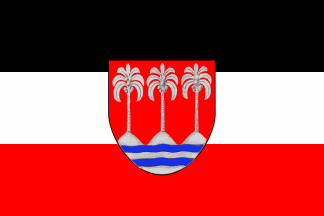 Flag Reconstruction by Fornax, 25 April 2011
Flag Reconstruction by Fornax, 25 April 2011
In 2010, Solf's original flag designs were discovered in the Bundesarchiv (Germany's central archive) in Koblenz by Harry D. Schurdel, which finally solved the mystery of the proposed colonial flag designs. This was one of those designs.
Pete Loeser, 25 April 2011
Proposed Coat of Arms Reconstruction by Fornax 25 April 2011 |
Flag Reconstruction by Fornax 25 April 2011 based on discoveries of Harry D. Schurdel 2010 |
Flag Reconstruction by Mark Sensen (Feb 98) based on traditional interpretation from Afrika-Nachrichten article 1933 |
Kamerun was occupied by British and French forces. Most of the territory became Territoire du Cameroun, under French mandate, and the rest under name Cameroons (I think there was another name, but I can't remember right now) became part of Nigeria for administrative purposes, but was govern as mandate territory until 1946.
Valentin Poposki, 26 April 2011
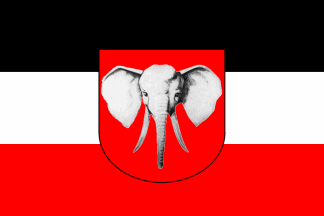 Flag Reconstruction by Fornax, 25 April 2011
Flag Reconstruction by Fornax, 25 April 2011
In 2010, Solf's original flag designs were discovered in the Bundesarchiv (Germany's central archive) in Koblenz by Harry D. Schurdel, which finally solved the mystery of the proposed colonial flag designs. This was one of those designs.
Pete Loeser, 25 April 2011
Proposed Coat of Arms Reconstruction by Fornax 25 April 2011 |
Flag Reconstruction by Fornax 25 April 2011 based on discoveries of Harry D. Schurdel 2010 |
Flag Reconstruction by Mark Sensen (Feb 98) based on traditional interpretation from Afrika-Nachrichten article 1933 |
Deutsch-Neuguinea became British Occupation Territory, although was occupied by combined Australian-Newzealand troops. Later (in 1920) became Mandate Territory of New Guinea, under Australian administration.
Valentin Poposki, 26 April 2011
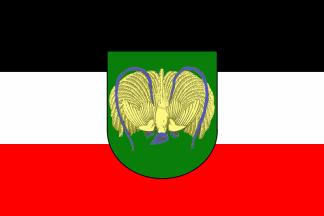 Flag Reconstruction by Fornax, 25 April 2011
Flag Reconstruction by Fornax, 25 April 2011
In 2010, Solf's original flag designs were discovered in the Bundesarchiv (Germany's central archive) in Koblenz by Harry D. Schurdel, which finally solved the mystery of the proposed colonial flag designs. This was one of those designs.
Pete Loeser, 25 April 2011
Editor's note: see also German New Guinea Company 1885-1899 (Deutsch Neuguinea-Kompagnie)
Proposed Coat of Arms Reconstruction by Fornax 25 April 2011 |
Flag Reconstruction by Fornax 25 April 2011 based on discoveries of Harry D. Schurdel 2010 |
Flag Reconstruction by Mark Sensen (Feb 98) based on traditional interpretation from Afrika-Nachrichten article 1933 |
Togo was occupied by British and French forces. British territory under the name Togoland became mandate territory administered by Gold Coast, and much later became part of independent Ghana. The French part was mandate territory which later became independent Republique Togolaise.
Valentin Poposki, 26 April 2011
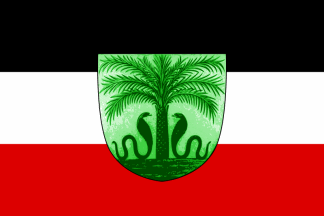 Flag Reconstruction by Fornax, 25 April 2011
Flag Reconstruction by Fornax, 25 April 2011
In 2010, Solf's original flag designs were discovered in the Bundesarchiv (Germany's central archive) in Koblenz by Harry D. Schurdel, which finally solved the mystery of the proposed colonial flag designs. This was one of those designs.
Pete Loeser, 25 April 2011
![[Togo doubtful flag]](../images/d/de!vtogo.gif) Image by Klaus-Michael Schneider, 26 Aug 2008
Image by Klaus-Michael Schneider, 26 Aug 2008
[Editorial comment: This doubtful flag design isn't so doubtful anymore. See one of Solf's original Togo flag designs above]
Proposed Coat of Arms Reconstruction by Fornax 25 April 2011 |
Flag Reconstruction by Fornax 25 April 2011 based on discoveries of Harry D. Schurdel 2010 |
Flag Reconstruction by Mark Sensen (Feb 98) based on traditional interpretation from Afrika-Nachrichten article 1933 |
Deutsch-Suedwestafrika was occupied by South African troops and in 1919 became Mandate Territory of Southwest Africa, under South African administration.
Valentin Poposki, 26 April 2011
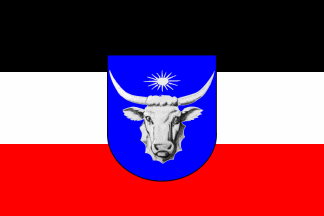 Flag Reconstruction by Fornax, 25 April 2011
Flag Reconstruction by Fornax, 25 April 2011
In 2010, Solf's original flag designs were discovered in the Bundesarchiv (Germany's central archive) in Koblenz by Harry D. Schurdel, which finally solved the mystery of the proposed colonial flag designs. This was one of those designs.
Pete Loeser, 28 April 2011
In Namibia the Imperial Kriegsflagge is the symbol most usually associated with German rule. The German Imperial flag is still very much in use by the German population. You can also get car stickers with "DSWA" for Deutsch Südwestafrika and other paraphernalia and there is a thriving industry in Swakopmund where German tourists can buy historical flags and emblems which they cannot buy back in Germany.
Stuart Notholt, 15 Feb 1996
The German administration of South West Africa lasted little more than three decades from 1884 to 1915. The 1914 colonial flag proposals were to be based on the German horizontal tricolour of black, white and red charged in the centre with a distinctive shield of the colony. In the case of South West Africa, this was to be a blue shield bearing a silver ox's head and diamond.
Bruce Berry, 13 Feb 1998
Proposed Coat of Arms Reconstruction by Fornax 25 April 2011 |
Flag Reconstruction by Fornax 25 April 2011 based on discoveries of Harry D. Schurdel 2010 |
Flag Reconstruction by Mark Sensen (Feb 98) based on traditional interpretation from Afrika-Nachrichten article 1933 |
Deutsch-Ostafrika was occupied by British, Belgian and Portuguese forces. British remain most of the territory which became Mandate Territory of Tanganyika in 1922; Belgian area became Ruanda-Urundi Protectorate, and Portuguese area became Distrito Kionga, later part of Mocambique.
Valentin Poposki, 26 April 2011
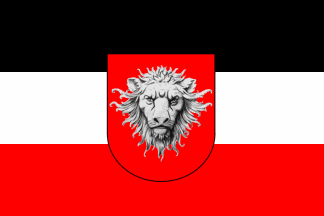 Flag Reconstruction by Fornax, 25 April 2011
Flag Reconstruction by Fornax, 25 April 2011
In 2010, Solf's original flag designs were discovered in the Bundesarchiv (Germany's central archive) in Koblenz by Harry D. Schurdel, which finally solved the mystery of the proposed colonial flag designs. This was one of those designs.
Pete Loeser, 25 April 2011
With the outbreak of war in 1914, the British moved to occupy the territory. Unfortunately for the tens of thousands of British, Indian, South African and other Empire troops eventually bogged down in East Africa, the German forces commander, Colonel Paul von Lettow-Vorbeck, was a brilliant guerrilla leader. By the end of the European war in 1918, von Lettow and his troops (most of whom were black, by the way) were still in the field, having led no less a figure than the South African General Jan Christiaan Smuts a merry dance through the bush, including
excursions into Kenya and the Portuguese territory of Mozambique (Portugal being an ally of Britain during World War I).
Stuart Notholt, 29 Jun 1996
There are coloured prints of the jack and ensign of a "German government vessels engaged in East African trade," in the 1892 amendments to the Admiralty Flag Book. The jack is the merchant flag with a plain blue anchor in the centre of the white band, and the ensign a Reichskriegsflagge with a plain blue anchor in the lower hoist. [National Archives (PRO) ADM 116/353]
The German civil ensign - a horizontal tricolor black white red - flew over Witu and was carried by askaris." A photograph shows the German flag being dipped to the Sultan of Witu when he reviewed askaris in front of his palace c1882. [Article "The Forgotten Flags of Witu" by James Marill in (probably) an issue of the Flag Bulletin]
David Prothero, 28 Oct 2003
Wituland (a part of German East Africa) was exchanged with Great Britain for Heligoland (a small archipelago in the North Sea) in 1890. Wituland became part of the Witu Protectorate, and is now part of Kenya.
Links suggested by Bruce Berry, 28 April 2011
![[Ralik Islands 1878-1885 (Germany)]](../images/d/de-ralik.gif) Image by Jaume Ollé
Image by Jaume Ollé
Schurdel 1995 mentions the flag of
the Ralik Islands [nowadays part of the Marshall Islands]
which had five stripes of black-white-red-white-black. The flag was used
from 19 November 1878 to 15 October 1885.
Pascal Vagnat, 21 Feb 1996
The Ralik Islands are part of the Marshall Islands in the Pacific Ocean. In 1878, Captain B. Werner of the German Cruiser SMK Ariadne, signed an agreement with local chiefs to use Jaluit Atoll as a German Coaling station. Captain Werner gave a flag to the chiefs on the last day of their stay described as the national flag, but with two additional stripes, one white and one black. Apparently the flag was well received by the locals and was still in use until at least 1883. Records indicate that in 1883, at least 67 ships, of which 11 flew the flag of the Ralik, were re-coaled there. The actual colonization of the Islands by the German Empire began later in 1885.
Text modified from Historical Flags of Our Ancestors, 27 April 2011
Flag Reconstruction by Jaume Ollé (2/7/97) First design of flag submitted |
Modified Coat of Arms by Fornax |
Flag Reconstruction by Fornax (25/4/2011) Final approved Flag Design |
This is the flag and shield of Tanga, German East Africa (1914).
Jaume Ollé, 02 Jul 1997
(The city of Tanga sits on the Indian Ocean, near the border with Kenya, and is the most northerly seaport city of Tanzania. Today, it is the regional seat of the surrounding Tanga Region. - Ed.)
With the outbreak of war in 1914, the British moved to occupy the territory. Unfortunately for the tens of thousands of British, Indian, South African and other Empire troops eventually bogged down in East Africa, the German forces commander, Colonel Paul von Lettow-Vorbeck, was a brilliant guerrilla leader. By the end of the European war in 1918, von Lettow and his troops (most of whom were black, by the way) were still in the field, having led no less a figure than the South African General Jan Christiaan Smuts a merry dance through the bush, including excursions into Kenya and the Portuguese territory of Mozambique (Portugal being an ally of Britain during World War I).
Stuart Notholt, 29 Jun 1996
By the middle of 1914, the first draft for the Tanga coat-of-arms and flag was being examined by the Heroldsamt (Supreme Heraldic Office) in Berlin. The Heroldsamt recommended a few design changes which resulted in a second and final draft. However, the documents of the Supreme Colonial Office indicate that neither version of the arms nor any flag were ever officially approved and that the whole case was dropped after East Africa had been lost to the Allies.
Text from Historical Flags of Our Ancestors, 25 April 2011
[As far as we can determine, the following Deutsche Kolonien (German Colonies), Schutzgebiete (Protectorates), or Territorien (territories), used either the Reichsdienstflaggen des Auswärtigen Amtes (Foreign Office Flag) or the Kaiserliche Kriegsflagge (Imperial Ensign) rather than any other special flags. - Ed.]
The Karolinen-Inseln (Caroline Islands) fell under Japanese occupation and remain in that situation (under mandate) until the US occupation in 1944, and later became a part of United States Trust Territory of Pacific Islands. Since then the Caroline Islands have been divided between the Federated States of Micronesia and Republic of Palau.
Marianen has the same fate as Karolinen. It is now a part of the Northern Mariana Islands.
Marschall-Inseln, same as Karolinen and Marianen.
Kiautschou (now Jiaozhou) was one of the many Treaty Ports that were created in China mainland during late 1880s, that was ceded to Germany. The main port and capital of the territory was Tsingtau (now Qingdao). It was occupied by Japanese troops and was handed back to China in December 1922.
Valentin Poposki, 26 April 2011